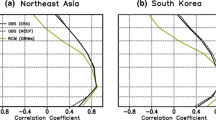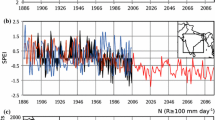Abstract
The hydrologic changes and the impact of these changes constitute a fundamental global-warming-related concern. Faced with threats to human life and natural ecosystems, such as droughts, floods, and soil erosion, water resource planners must increasingly make future risk assessments. Though hydrological predictions associated with the global climate change are already being performed, mainly through the use of GCMs, coarse spatial resolutions and uncertain physical processes limit the representation of terrestrial water/energy interactions and the variability in such systems as the Asian monsoon. Despite numerous studies, the regional responses of hydrologic changes resulting from climate change remains inconclusive. In this paper, an attempt at dynamical downscaling of future hydrologic projection under global climate change in Asia is addressed. The authors conducted present and future Asian regional climate simulations which were nested in the results of Atmospheric General Circulation Model (AGCM) experiments. The regional climate model could capture the general simulated features of the AGCM. Also, some regional phenomena such as orographic precipitation, which did not appear in the outcome of the AGCM simulation, were successfully produced. Under global warming, the increase of water vapor associated with the warmed air temperature was projected. It was projected to bring more abundant water vapor to the southern portions of India and the Bay of Bengal, and to enhance precipitation especially over the mountainous regions, the western part of India and the southern edge of the Tibetan Plateau. As a result of the changes in the synoptic flow patterns and precipitation under global warming, the increases of annual mean precipitation and surface runoff were projected in many regions of Asia. However, both the positive and negative changes of seasonal surface runoff were projected in some regions which will increase the flood risk and cause a mismatch between water demand and water availability in the agricultural season.
Similar content being viewed by others
References
Arakawa, A., and W. H. Schubert, 1974: Interaction of a cumulus cloud ensemble with the large-scale environment, Part I. J. Atmos. Sci., 31, 674–701.
Castro, C. L., R. A. Pielke Sr., and G. Leoncini, 2005: Dynamical downscaling: Assessment of value retained and added using the Regional Atmospheric Modeling System (RAMS). J. Geophys. Res., 110, doi: 101029/2004J.
Coe, M. T., 2000: Modeling terrestrial hydrological systems at the continental scale: Testing the accuracy of an atmospheric GCM. J. Climate, 13, 686–704.
Collins, M., 2007: Ensembles and probabilities: A new era in the prediction of climate change. Philos. Trans. Roy. Soc. London A, 365, 1957–1970.
Dairaku, K., and S. Emori, 2006: Dynamic and thermodynamic influences on intensified daily rainfall during the Asian summer monsoon under doubled atmospheric CO2 conditions. Geophys. Res. Lett., 33, L01704, doi: 101029/2005GL024754.
Emori, S., T. Nozawa, A. Numaguti, and I. Uno, 2001: Importance of cumulus parameterization for precipitation simulation over East Asia in June. J. Meteor. Soc. Japan, 79, 939–947.
Fu, C., F. W. T. Penning de Vries, Ailikun, C. T. A. Chen, L. Lebel, M. Manton, A. Snidvongs, and H. Virji, Eds, 2006: The initial science plan of the Monsoon Asia Integrated Regional Study. MAIRS-IPO, IAP-CAS, Beijing, China, 80pp.
Giorgi, F., and L. O. Mearns, 1999: Introdution to special section: Regional climate modeling revisited. J. Geophys. Res., 104, 6335–6352 98JD02072.
Huffman, G. J., and Coauthors, 1997: The Global Precipitation Climatology Project (GPCP) combined precipitation dataset. Bull. Amer. Meteor. Soc., 78, 5–20.
Huffman, G. J., R. F. Adler, M. M. Morrissey, D. T. Bolvin, S. Curtis, R. Joyce, B. McGavock, and J. Susskind, 2001: Global precipitation at one-degree daily resolution from multisatellite observations. J. Hydrometeor., 2, 36–50.
IPCC, 2001: Climate Change 2001: The Scientific Basis. Contribution of Working Group I to the Third Assessment Report of the Intergovernmental Panel on Climate Change. Houghton et al., Eds., Cambridge University Press, Cambridge, United Kingdom and New York, NY, USA, 881pp.
Koster, R. D., M. J. Suarez, and M. Heiser, 2000: Variance and predictability of precipitation at seasonalto-interannual timescales. J. Hydrometeor., 1, 26–46.
Mellor, G. L., and T. Yamada, 1974: A hierarchy of turbulence closure models for planetary boundary layers. J. Atmos. Sci., 31, 1791–1806.
Mellor, G. L., and T. Yamada, 1982: Development of a turbulence closure model for geophysical fluid problems. Rev. Geophys., 20, 851–875.
Milly, P. C. D., R. T. Wetherald, K. A. Dunne, and T. L. Delworth, 2002: Increasing risk of great foods in a changing climate. Nature, 415, 514–517.
Nakajima, T., M. Tsukamoto, Y. Tsushima, A. Numaguti, and T. Kimura, 2000: Modelling of the radiative process in an atmospheric general circulation model. Appl. Opt., 39, 4869–4878.
Numaguti, A., M. Takahashi, T Nakajima, and A. Sumi, 1997: Description of CCSR/NIES Atmospheric General Circulation Model. CGER’s Supercomputer Monograph Report. 3, Center for Global Environmental Research, National Institute for Environmental Studies, 1–48.
Palmer, T. N., and J. Rälsänen, 2002: Quantifying the risk of extreme seasonal precipitation events in a changing climate. Nature, 415, 512–514.
Pielke, R. A., and Coauthors, 1992: A comprehensive meteorological modeling—RAMS. Meteor. Atmos. Phys., 49, 69–91.
Pielke, Sr. R. A., Ed., 2002: Mesoscale Meteorological Modeling. 2nd ed., Academic Press, 676pp.
Rayner, N. A., E. B. Horton, D. E. Parker, C. K. Folland, and R. B. Hackett, 1996: Version 2.2 of the global sea-ice and sea surface temperature data set, 1903–1994. Climate Research Technical (CRTN) No. 74, 43pp. [Available from The Met Office, London Road, Bracknell, UK]
Schnur, R., 2002: The investment forecast. Nature, 415, 483–484.
Suh, M.-S., and D.-K. Lee, 2004: Impacts of land use/cover changes on surface climate over east Asia for extreme climate cases using RegCM2. J. Geophys. Res., 109, doi: 101029/2003J.
Takata, K., S. Emori, and T. Watanabe, 2003: Development of the minimal advanced treatments of surface interaction and runoff. Global and Planetary Change, 38, 209–222.
Takayabu, I., H. Kato, K. Nishizawa, Y. N. Takayabu, Y. Sato, H. Sasaki, K. Kurihara, and A. Kitoh, 2007: Future projections in precipitation over Asia simulated by two RCMs nested into MRI-CGCM2.2. J. Meteor. Soc. Japan, 85, 511–519.
Vörösmarty, C. J., P. Green, J. Salisbury, and R. B. Lammers, 2000: Global Water Resources: Vulnerability from Climate Change and Population Growth. Science, 289, 284–288.
Wang, Y., L. R. Leung, J. L. McGregor, D.-K. Lee, W.-C. Wang, Y. Ding, and F. Kimura, 2004: Regional Climate Modeling: Progress, Challenges, and Prospects. J. Meteor. Soc. Japan, 82, 1599–1628.
Xie, P., and P. A. Arkin, 1997: Global Precipitation: A 17-Year Monthly Analysis Based on Gauge Observations, Satellite Estimates, and Numerical Model Outputs. Bull. Amer. Meteor. Soc., 78, 2539–2558.
Author information
Authors and Affiliations
Corresponding author
Rights and permissions
About this article
Cite this article
Dairaku, K., Emori, S. & Nozawa, T. Impacts of global warming on hydrological cycles in the Asian monsoon region. Adv. Atmos. Sci. 25, 960–973 (2008). https://doi.org/10.1007/s00376-008-0960-1
Received:
Revised:
Published:
Issue Date:
DOI: https://doi.org/10.1007/s00376-008-0960-1




